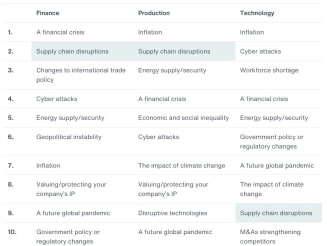4 Ways to Build Resilient and Agile Supply Chains

How can leaders build a strong and adaptable supply chain for business survival and growth during uncertain times?
Key Takeaways
-
Supply chain disruption is one of the top five business risks that leaders are most focused on.
-
Supply chain risks are highly interconnected and continue to evolve.
-
Leaders must proactively take an enterprise approach to supply chain risk management, leveraging data-driven insights and a collaborative framework.
In the face of a changing risk landscape, global supply chains are being tested to the limit. According to Aon’s 2022 Executive Risk Survey of 800 C-suite leaders and senior executives across markets, supply chain disruptions are among the top five business risks, and especially impact finance, production, and technology companies.

Source: Aon’s 2022 Executive Survey
Supply Chain Risks Are Complex and Multifaceted
The highly interdependent and globalized supply chains of today face multifaceted and complex risks, with incidents in one part of the world resulting in significant and costly disruptions for businesses everywhere. Losses from supply chain disruptions can amount to an average of more than 40 percent of annual EBITDA every decade1.
Supply Chain Risks Impacting Businesses Today
Risk #1: Climate change and frequent natural catastrophes, such as hurricanes, floods, droughts, and wildfires are impacting operations and transport globally.
Risk #2: Geopolitical tensions have resulted in price hikes and volatility for energy, food, and raw materials, increasing costs and impacting revenue for companies globally.
Risk #3: Talent constraints such as labor shortages and strikes, are further compounding supply chain risks despite business leaders spending more time and resources to attract and retain top talent.
Risk #4: The pandemic has caused container vessels congestion and a global supply chain crunch for goods highlighting the need for supply chain visibility to ensure cost optimization.
Supply Chain Risks Are Highly Interconnected
In a complex risk landscape, it is necessary to look beyond the first tier of buyer-supplier relationships and consider how different risk categories intersect. A network-level approach can show how events can have a ripple effect across borders and exacerbate issues downstream.
Individual supplier risks encompass operational, financial, reputational, and structural problems. Natural disasters and geopolitical and fiscal risks happen at the regional/national level. More broadly, there are also industry risks to consider, such as the effects and implications of new technologies.

Source: Aon
Higher-level risks can lead to regulatory pressures in the form of international trade barriers including sanctions, embargoes, and tariffs. Businesses may also make voluntary supplier changes in the interests of maintaining their reputation and fulfilling ESG commitments, for example by terminating relationships with suppliers in countries involved in international political conflicts or human rights abuses.
Aon’s Executive Risk Survey found that confident leaders welcome this complicated interplay of risks as a necessary challenge rather than a dangerous unknown. Such businesses prepare for, finance, and respond to unplanned events and volatile supplier performance by leveraging improved insights around where and how risk impacts the supply chain.
Gaps in Conventional Insurance
- Quantitative issues.
These concern the “plume” of tiers (who/where), which affect aggregations and accumulations to carriers, and their potential financial impact. - Qualitative issues.
These require the identification and understanding of key bottlenecks, followed by the adoption of a combination of risk management approaches, including business continuity plans, disaster-recovery plans, construction occupancy protection exposure (COPE) information, and alternative or dual-source suppliers. - Growth in severity and frequency of losses.
- Greater exposure of certain industry verticals, such as life sciences, technology, and complex manufacturing.
- Non-physical damage-related perils that lead to business interruptions.

How to Build Resilient and Agile Supply Chains
Supply chains have become increasingly fragile over the past few decades, with companies seeking to drive efficiency and margins through sourcing of materials, ingredients, and components as well as the distribution of their end products.
Liquidity strategies based on the use of reduced inventories and ‘just-in-time’ fulfilment processes have further increased exposure to disruption. At the same time, the availability and relevance of insurance as a solution to supply chain risk is reducing.
To effectively respond to these challenges, it is vital for businesses to be proactive.
1. Quantify risks. Leverage data analytics and forecasting capabilities to methodically quantify risk and financial impacts, assess and align macro exposures to specific industry sector events, and identify opportunities to enhance risk policies. Leverage data sets around loss and claims to identify future triggers and exposures.
2. Agree on which contracts, customers, and products need protection first. Prioritize based on probability, impact, and detectability of the risk. Then future-proof critical business activities through appropriate risk mitigation and risk finance transfer strategies.
4. Break down silos. Pursue cost and production efficiencies that align existing supply chain processes and procurement operations with insurance, risk management, and finance teams. Work with external advisors and consultants to devise an integrated supply chain risk strategy that smooths volatipty and associated costs.
For more information on Supply Chain risks, download our full 2022 Executive Risk Survey Report.
1McKinsey Global Institute: Risk, resipence, and rebalancing in global value chains
1/3
of active container ships stalled outside ports worldwide between April 12 and 13 in 2022, were held up around China
Source: Windward
General Disclaimer
The information contained herein and the statements expressed are of a general nature and are not intended to address the circumstances of any particular individual or entity. Although we endeavor to provide accurate and timely information and use sources we consider reliable, there can be no guarantee that such information is accurate as of the date it is received or that it will continue to be accurate in the future. No one should act on such information without appropriate professional advice after a thorough examination of the particular situation.
Terms of Use
The contents herein may not be reproduced, reused, reprinted or redistributed without the expressed written consent of Aon, unless otherwise authorized by Aon. To use information contained herein, please write to our team.
Insights for HR
This collection is a set of featured articles.
Cyber Labs
Stay in the loop on today's most pressing cyber security matters.
Environmental, Social and Governance Insights
Explore Aon's latest environmental social and governance (ESG) insights.
Insights for HR
Explore our hand-picked insights for human resources professionals.
Navigating Volatility
How do businesses navigate their way through new forms of volatility and make decisions that protect and grow their organizations?





















